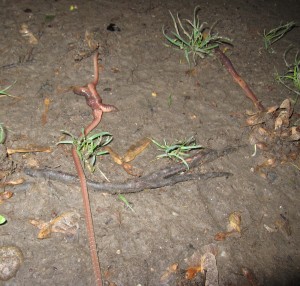This post originally ran May 31, 2012. But you won’t even notice. Worm sex is perhaps the most evergreen of evergreen topics.

My husband and I often take nighttime walks. On one such walk, I noticed something strange on the ground. It looked like a shiny stick. I leaned in for a closer look and realized I was looking at a long, fat worm. “Is this a worm?” I asked my husband. (I like to ask questions for which I already have an answer.) As he made his way over, I spotted more worms. The scruffy patch of dirt between the sidewalk and the curb was laced with them. “Oh God!” I yelped. “They’re everywhere. Look at them all!” I was shouting now. “Where did they come from!?”
My first thought was that someone had dumped their fishing bait. But as we circled the block, I noticed more worms. Hundreds of worms. This was no bait dump. The entire worm community seemed to be above ground. I couldn’t see well, so I ran into the house to get a headlamp. And, yes, there they were, dozens upon dozens of long pink bodies, all groping the ground with their pointy heads.
I ran back inside. My husband was watching TV. “Sex!” I screamed. “They’re having sex.” I was sure of it. But just to be double sure, I googled. Up came dozens of pictures of worms fornicating. They looked exactly like the worms in my front yard. I was elated. I felt like Christopher Flipping Columbus setting foot on the shores of an unknown continent. Except the continent was my front yard. And instead of people, I found worms.In one spot, I found two worms that seemed to be attached. These worms lay perfectly still. This could only be one thing. Sex. Worm orgy. And I had front row seats.
I had a boatload of questions. How common is this? How do worms mate? How do they all know to come to the surface at the same time? Why were there so many of them? Why have I never seen this before?
Luckily I’m a science journalist. I get paid to ask questions. So I dialed Mac Callaham, a worm guy at the USDA Forest Service’s Southern Research Station in Georgia. How much does he love earthworms? He’s working on a handbook of the earthworms of North America . . . in his spare time.
 Here’s the first thing Mac told me: These worms, like many Brooklynites, are immigrants. New York has no native earthworms. “So what you’re looking at is most likely a European species that has been introduced called a nightcrawler,” Callaham said. “This particular species builds long, deep, permanent burrows.” At night, they crawl to the surface to feed. “They do this every single night that conditions are good,” he added.
Here’s the first thing Mac told me: These worms, like many Brooklynites, are immigrants. New York has no native earthworms. “So what you’re looking at is most likely a European species that has been introduced called a nightcrawler,” Callaham said. “This particular species builds long, deep, permanent burrows.” At night, they crawl to the surface to feed. “They do this every single night that conditions are good,” he added.
Yes, yes. But what about the mating? Callaham admits he’s not necessarily an expert on earthworm reproduction. But he used to work with them in the lab. “Three times out of ten when I opened the container they were in copula,” he says. His observations support what Clive Edwards — the man who literally wrote the book on earthworms (Biology and Ecology of Earthworms, 1996) — told me in an email. “I am sorry to disappoint you,” Edwards wrote, “but there is nothing new about what you saw. The earthworms that you saw were the species Lumbricus terrestris, which was first described [by] Linnaeus.” In a primer on soil biology, Edwards writes that earthworms “mate periodically throughout the year, except when environmental conditions are unfavorable.”
Ok, so worms having sex is a common occurrence that has been documented for centuries. Thanks, Killjoy Edwards. But do you, dear readers, know HOW Lumbricus terrestris has sex? I didn’t think so. I’m about to educate you.
Worms are hermaphrodites — they have male and female parts. So when they mate, they are actually just swapping sperm. Here’s how it works: When the worms are feeling amorous (that is, when conditions are right), they anchor their tails in their burrows and probe the ground in search of other worms. But not just any worm will do. “They size each other up, so to speak, and then they make a selection,” Callaham says. Next, the two worms align themselves so that their heads are facing opposite directions. What follows delights me: “The worms form slime tubes to help adhere to each other during copulation which may take as long as an hour,” writes Clive Edwards. Slime tubes!
Head safely encased in slime, each worm deposits semen into its partner’s sperm sac, where sperm gets stored. Then the worms part ways. No eggs have been fertilized. That happens later. Earthworms can store their partner’s semen for a long time. Once a worm’s eggs have matured, it secretes a cocoon. As it wriggles out of this cocoon, it deposits both semen and eggs inside of it. Fertilization happens in the cocoon, not in the worm. The cocoon incubates in the soil, and eventually baby worms hatch. Am I the only one who thinks this is cool? Yes? Oh, ok.
I had one more question for Mac. If this behavior is so common, why have I never seen it before? Mac pointed out that most people walk around completely oblivious to the tiny dramas that are playing out below their very noses. I, apparently, am no exception. I simply hadn’t been paying attention. “There’s a whole unbelievable world down there that people are totally unaware of. And you just got a glimpse into it,” he told me. “You’re one of the lucky ones.”
**
Image credits:
Girl holding worm courtesy of KRISnFRED. Worm sex image taken by yours truly.